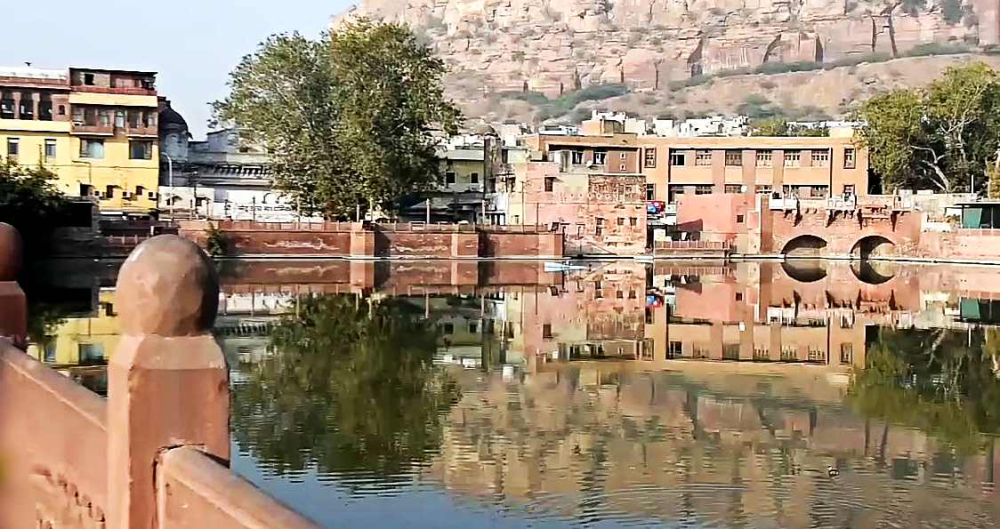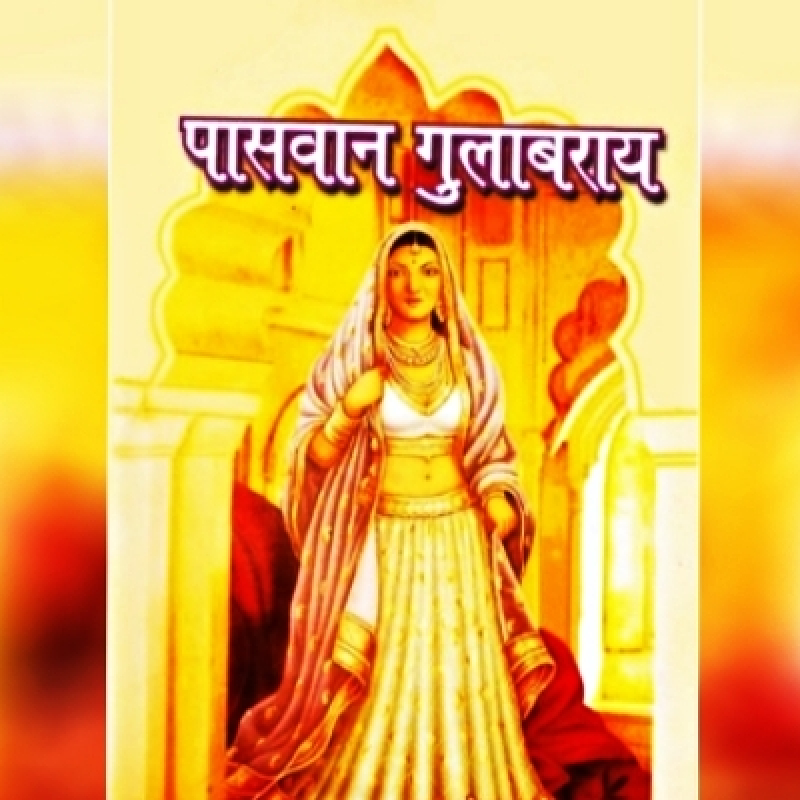With the waning power of the Mughals in the eighteenth century, slaves, especially concubines, close to the ruler wielded great influence and power in the state of Rajputana. But how? We investigate how the companionship between Maharaja Vijay Singh and his chief concubine Gulabrai—compared with Jahangir and Nur Jahan—holds the answer. (Photo courtesy: Shubhada Prakashan, Jodhpur, Rajasthan)
In South Asian history, where memory and symbolism are inextricably entwined, temples symbolised the political power of their patrons. Temple patronage indicated the shifting patterns of this power as one influential courtier replaced another and acquired state sanction for significant temples.[1] But this was not always restricted to courtiers.
An example is the beautiful eighteenth-century Kunjbihari temple at Jodhpur—commissioned by Gulabrai, a paswan (concubine) of Maharaja Vijay Singh (AD 1752–93) of Marwar. In a city full of innumerable temples, this replica of the more famous Ghanshyamji Temple is special because of its patronage. A mural on the ceiling of the temple’s mandapa shows Gulabrai and Maharaja Vijay articulating their affiliation to the Vallabha sect.
Also read | The Urban History of Jodhpur
This mural is meaningful in many ways. The proximity shared by the pair in the painting symbolises their attachment and an intimacy that was tethered to the spiritual domain.[2] More importantly, it indicates a concubine’s political prominence and centrality in the promotion of the state religion.[3]

Battles, Slaves and State Formation
While Rajputs (meaning ‘Son of a king’) are known to have a set clan structure since the seventh–twelfth centuries, a closer look at the historic region of Rajputana (Land of the Rajputs) reveals that the margins of clan, lineage and jati (caste) were not as iron-clad as claimed by courtly sources.[4] Recurring battles for territorial expansion ensured a constant flux of war captives, leading to enslavement of women. Ramya Sreenivasan, in ‘Drudges, Dancing Girls, and Concubines’, writes, these slaves performed different services to meet the labour needs of Rajput households while also contending their status in a ‘competitive polity and evolving jati hierarchy’.[5] However, the increasing inability of the Mughal emperor to act as the arbiter of these clan contests in the eighteenth century, exacerbated the factional fights within elite households. At this time, slaves, especially concubines, close to the ruler wielded great influence and power.[6] But how? The companionship between Gulabrai and Maharaja Vijay holds the answer.

Eighteenth-century Court Economy of Marwar
Just like a Mughal harem, the institution of concubinage was hierarchically organised in the polygynous households of Marwar. Gulabrai’s journey up the ladder, as testified by various sources and khyats (Rajasthani court histories), goes through the various steps. Historian Priyanka Khanna notes:
In 1766 AD Gulab Rai, initially the badaran [female slave] of Bhurat Argadram (a courtier), entered the royal service of Maharaja Vijay Singh. Gulabrai was from the Oswal (Jain) community. She was gradually raised to the status of a singer (gayan) at the court followed by the status of a royal servant (khawas). Soon she caught the fancy of Maharaja Vijay Singh and was initiated as his concubine with the title of pardayat. In 1774 AD she was ultimately raised to the status of a paswan [derived from pas (to be close) and wan (to), which was the highest title, sometimes rivalling the power of even the queens[7] by the Maharaja with assent from the court circle[8] [this included the noble Singhvi Bhimraj, an ally of Gulabrai, and whose support was later rewarded by her ensuring the appointment of Bhimraj’s son as Baskshi[9]. The status of a paswan helped Gulab Rai to amass additional material and political prerogatives which were wisely manipulated by her to assert an active and powerful agency in the matters of the Rathor sovereignty.
In 1775, she built the Mahilabagh Mahal, interlaid with a large step tank and several gardens, and got the lake of Gulab Sagar excavated in Jodhpur city.[10] That the king and her had shared interests, including spirituality, is evidenced in the fact that he adopted the Vallabha sect of Vaishnavism soon after a pilgrimage with Gulabrai to Nathwada, a major Vaishnava centre in western Rajasthan.[11]
Also read | An Institutional History of Rupayan Sansthan, Jodhpur
'Maharaja Shree Vijay Singh Ri Khyat’ recounts that in 1777, Gulabrai shifted to Mahilabagh after a dispute with the Shekhawati Maharani, one of the queens. Jodhpur’s daily records, the Haqiqat Bahi, suggests that Vijay Singh chose to live in Mahilabagh with Gulabrai, clearly showing an affinity for her that exceeded that for his queens.
Historian Kaviraj Shyamaldas claimed that Vijay Singh’s relationship with Gulabrai was like that of Jahangir with Nur Jahan—the king tacitly following his paswan’s bidding.[12] In 1792, when the chief’s grandson seized the fort, and Gulabrai was murdered, Shyamaldas recalls how Vijay Singh, overcome with sorrow, passed away a year after.[13]

Beyond Marwar
While Gulabrai’s rise to power and wealth was significant, it was not unusual. Even after the eighteenth century, some concubines continued to wield power. In Jaipur, Raskapur was elevated to the status of Raja Jagat Singh’s (r. 1803–18) wives from the Bhati and Rathore clans.[14] Rupa badaran held great sway in the court of Jaipur during 1818–36.[15]
Moreover, male slave-progeny, who served their kin loyally, were recognised in courtly traditions and often integrated into the household as foster brothers. Raval Man Singh, the son of Banswada’s Raval Pratap Singh, by the khawas Padma, was even anointed ruler when the king died without any male heirs.[16]
Also read | The Oral Historian from Borunda: Komal Kothari
But as the Rajput chiefdoms became ‘subsidiary’ powers under the British, a new Victorian morality was impressed on their polity. The prevalence of concubines among Rajputs was used to relegate them to ‘semi-barbarous nations’ of ‘The Orient’, according to Sreenivasan.[17] For instance, the influential Rupa badaran was now accused of being an intruder and corrupting the Rajputs.[18] At the same time, a stronger ideology of lineage ‘purity’ emerged among the Rajput elites, consequently restricting the potential for upward mobility of an outsider within these households in the nineteenth century.[19]
This content has been created as part of a project partnered with Royal Rajasthan Foundation, the social impact arm of Rajasthan Royals, to document the cultural heritage of the state of Rajasthan.
The article was also published on Scroll.
Notes
[1] Karen Leonard, ‘Hindu Temples in Hyderabad: State Patronage and Politics in South Asia’, South Asian History and Culture 2, no. 3 (United Kingdom: Routledge, 2011), doi: 10.1080/19472498.2011.577568.
[2] Priyanka Khanna, ‘The Female Companion in a World of Men: Friendship and Concubinage in Late Eighteenth-Century Marwar’, Studies in History 33, no. 1 (February 2017), doi: 10.1177/0257643016677458.
[3] Ibid.
[4] Ramya Sreenivasan, ‘Drudges, Dancing Girls, and Concubines’, in Slavery and South Asian History, eds Indrani Chatterjee and Richard M. Eaton (Bloomington: Indiana University Press, 2006).
[5] Ibid.
[6] Ibid.
[7] Ibid.
[8] Brajesh Kumar Singh (ed.), Maharaja Shree Vijay Singh Ri Khyat, serial no. 185, Jodhpur, 1997, p. 1.
[9] A baskshi is a chief military officer in the central administration.
[10] Priyanka Khanna, ‘The Female Companion in a World of Men: Friendship and Concubinage in Late Eighteenth-Century Marwar’, Studies in History 33, no. 1 (February 2017), doi: 10.1177/0257643016677458.
[11] Ibid.
[12] Ramya Sreenivasan, ‘Drudges, Dancing Girls, and Concubines’, in Slavery and South Asian History, eds Indrani Chatterjee and Richard M. Eaton (Bloomington: Indiana University Press, 2006).
[13] ibid.
[14] Ibid.
[15] Ibid.
[16] Ibid.
[17] Ibid.
[18] Ibid.
[19] Ibid.












